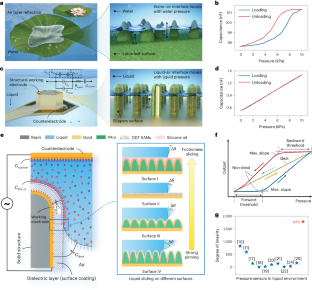2023-08-18 シンガポール国立大学(NUS)
◆eAirセンサーは、腹腔鏡手術の手触りフィードバック向上や頭蓋内圧監視の改善に革命をもたらす可能性があり、ハスの葉の撥水効果を模倣した設計により高感度な圧力検出を実現。2023年8月17日に研究成果が発表された。
<関連情報>
- https://news.nus.edu.sg/nature-inspired-pressure-sensing-technology/
- https://www.nature.com/articles/s41563-023-01628-8
理想に近い空気弾性圧力センシングのための摩擦のない多相インターフェース Frictionless multiphasic interface for near-ideal aero-elastic pressure sensing
Wen Cheng,Xinyu Wang,Ze Xiong,Jun Liu,Zhuangjian Liu,Yunxia Jin,Haicheng Yao,Tak-Sing Wong,John S. Ho &Benjamin C. K. Tee
Nature Materials Published:17 August 2023
DOI:https://doi.org/10.1038/s41563-023-01628-8

Abstract
Conventional pressure sensors rely on solid sensing elements. Instead, inspired by the air entrapment phenomenon on the surfaces of submerged lotus leaves, we designed a pressure sensor that uses the solid–liquid–liquid–gas multiphasic interfaces and the trapped elastic air layer to modulate capacitance changes with pressure at the interfaces. By creating an ultraslippery interface and structuring the electrodes at the nanoscale and microscale, we achieve near-friction-free contact line motion and thus near-ideal pressure-sensing performance. Using a closed-cell pillar array structure in synergy with the ultraslippery electrode surface, our sensor achieved outstanding linearity (R2 = 0.99944 ± 0.00015; nonlinearity, 1.49 ± 0.17%) while simultaneously possessing ultralow hysteresis (1.34 ± 0.20%) and very high sensitivity (79.1 ± 4.3 pF kPa−1). The sensor can operate under turbulent flow, in in vivo biological environments and during laparoscopic procedures. We anticipate that such a strategy will enable ultrasensitive and ultraprecise pressure monitoring in complex fluid environments with performance beyond the reach of the current state-of-the-art.



